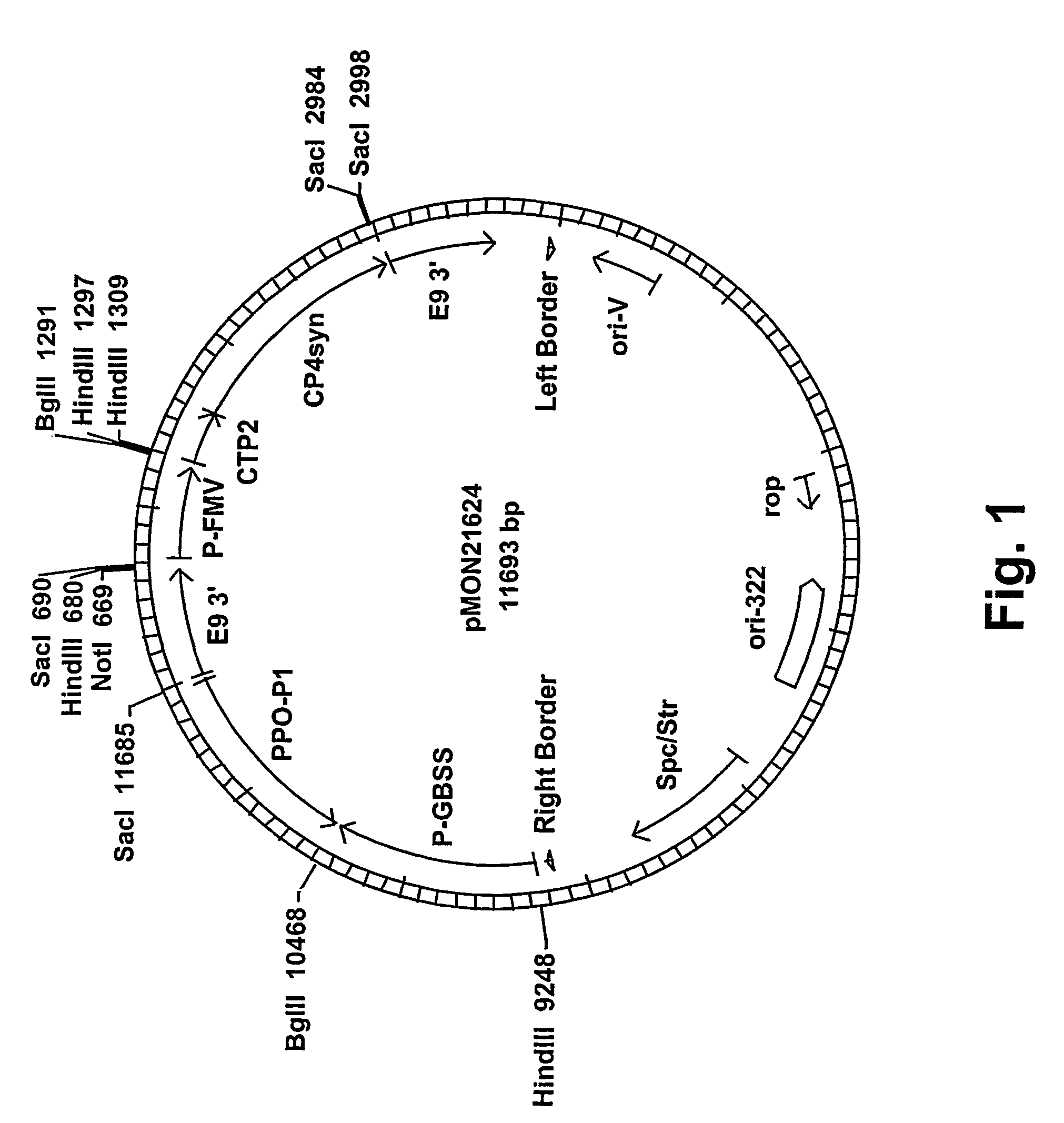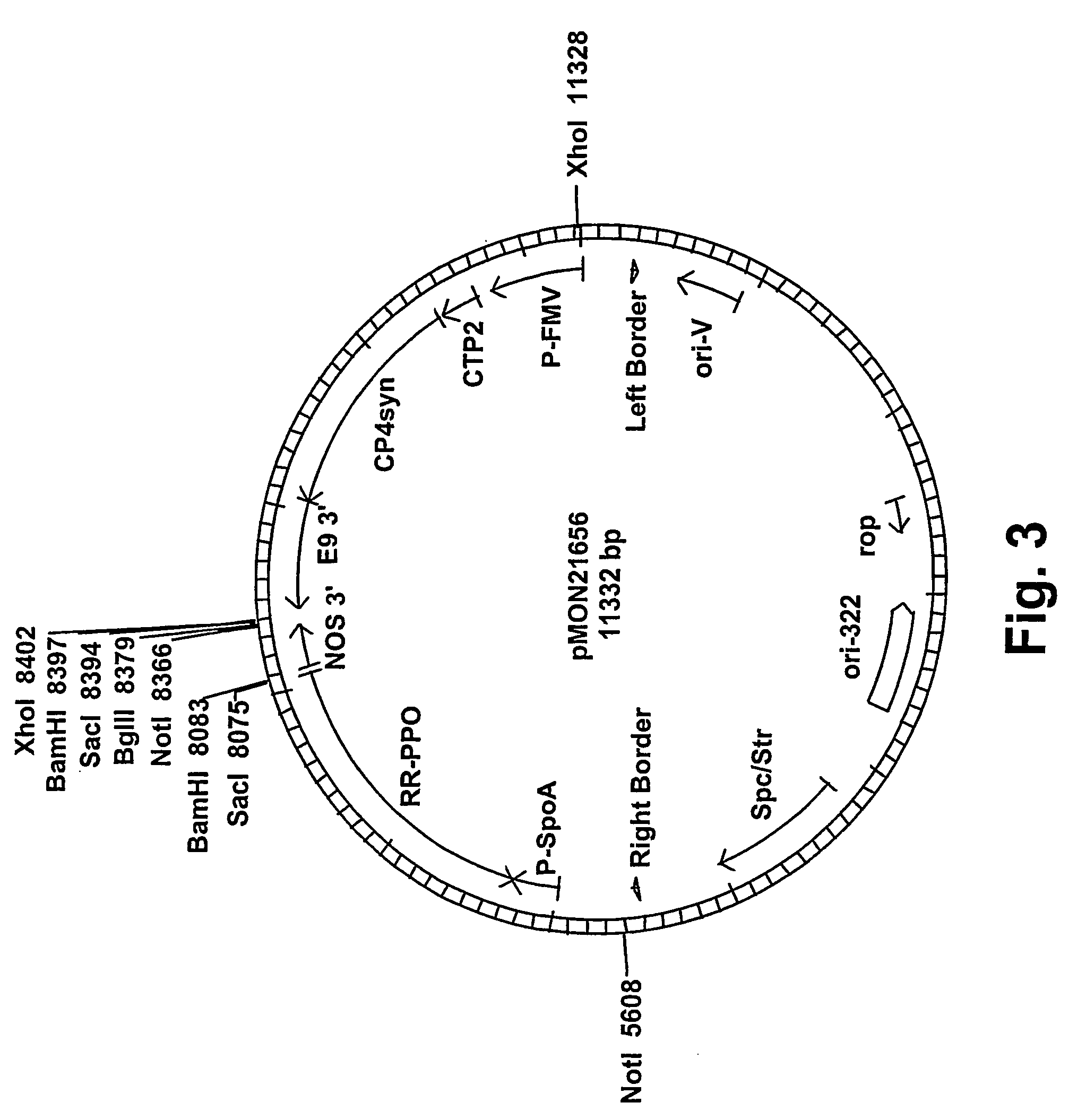Method of imparting disease resistance to plants by reducing polyphenol oxidase activities
a technology of polyphenol oxidase and plant, applied in the field of transformation plants, can solve the problems of lack of effective r-genes in cultivated potato, lack of cost-effective means of us-8 control, and annual potato loss exceeding 100 million dollars, so as to reduce the symptoms of disease, reduce the expression of polyphenol oxidase (ppo), and reduce damag
- Summary
- Abstract
- Description
- Claims
- Application Information
AI Technical Summary
Benefits of technology
Problems solved by technology
Method used
Image
Examples
example 1
Construction of Antisense Plant Vectors
[0064]In order to obtain tuber-specific expression of the potato leaf cDNA, a plant expression vector, pMON21624, which contained the PPO-P1 sequence was constructed as follows: The PPO-P1 sequence was isolated from a potato leaf cDNA library as a SacI-BglII fragment, and fused in antisense orientation to the 3′ end of the e35S promoter and 5′ end of the E9 3′ nontranslated polyadenylation region by ligation into a SacI-BglII sites of a double-bordered binary Ti plasmid vector. The vector contained the e35S / NPTII / NOS 3′ selectable marker cassette, which confers plant resistance to kanamycin. From the resultant plasmid, pMON21621, the e35S promoter was removed as a HinDIII-BglII fragment and replaced with the potato GBSS promoter via ligation as a HinDIII-BglII fragment to produce pMON21622, which contains the GBSS / antisense PPO-P1 / E9, 3′ cassette. The e35S / NPTII / NOS 3′ cassette was then excised as a NotI-XhoI fragment from pMON21622. The FMV / CT...
example 2
Transformation, Expression and Regeneration of Potato
[0069]The constructs pMON21624, pMON21652, pMON21656, and pMON38914 were independently mobilized into disarmed ABI Agrobacterium tumefaciens strain by electroporation using a Bethesda Research Laboratories Cell-Porator according to the manufacturer's recommended protocol. Electroporated cells were allowed to recover in LB broth with shaking (200 rpm) at 30° C. for 2 hours. Transformed A. tumefaciens cells were selected by plating out the electroporated cells on LB agar containing 25 ug / ml chloramphenicol, 50 ug / ml kanamycin, and 75 ug / ml spectinomycin.
[0070]Russet Burbank and Ranger Russet potato cultivars underwent Agrobacterium-mediated transformation using a glyphosate selection transformation protocol as described in U.S. Pat. No. 4,970,168, incorporated in its entirety herein by reference. Russet Burbank cultivar was transformed with only pMON21624, while Ranger Russet cultivar was independently transformed with pMON21652, pM...
example 3
Oxidative Browning Assay and Catechol Assay for PPO Activity in Potato Tubers
[0072]Transgenic Russet Burbank and Ranger Russet lines were initially screened for tuber PPO activity using greenhouse-grown mini-tubers; Transgenic plantlets with sufficient root development in tissue culture were transplanted to soil which consisted of 2 parts Metro-350, 1 part fine sand, 1 part Ready-Earth in 12 inch wide pots. The plantlets were grown in a greenhouse in which conditions throughout a 4–5 month growth period included a 15 hr photoperiod, 40–60% relative humidity, fertilization with Peter's Special 20–20–20, and 24-27° C. day / 13–16° C. night incubation. At 2.5 months, fertilization was stopped, and upon senescence, tubers were harvested and stored at 4° C. until evaluation.
[0073]Mature greenhouse mini-tubers, as well as field-grown tubers were measured for PPO activity first by an Oxidative Browning Assay and then by a Catechol Assay. The Oxidative Browning Assay of tuber homogenates reli...
PUM
| Property | Measurement | Unit |
|---|---|---|
| TM | aaaaa | aaaaa |
| TM | aaaaa | aaaaa |
| pH | aaaaa | aaaaa |
Abstract
Description
Claims
Application Information
 Login to View More
Login to View More - R&D
- Intellectual Property
- Life Sciences
- Materials
- Tech Scout
- Unparalleled Data Quality
- Higher Quality Content
- 60% Fewer Hallucinations
Browse by: Latest US Patents, China's latest patents, Technical Efficacy Thesaurus, Application Domain, Technology Topic, Popular Technical Reports.
© 2025 PatSnap. All rights reserved.Legal|Privacy policy|Modern Slavery Act Transparency Statement|Sitemap|About US| Contact US: help@patsnap.com



